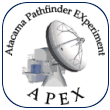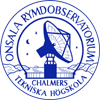Technical description of LABOCA
General
LABOCA is a multi-channel bolometer array for continuum observations. It operates in the 870 μm (345 GHz) atmospheric window. The array consists of 295 channels, which are arranged in 9 concentric hexagons around a central channel. The angular resolution is 18.6″ (HPBW), and the total field of view is 11.4′. With a channel separation of about 36″ (twice the beam size) the array is undersampled, thus special mapping techniques are used to obtain fully-sampled maps in a time-efficient manner.

The Bolometers
A bolometer is practically a thermometer. The radiation arriving at APEX from astronomical objects is absorbed by a thin metal film cooled to about 280 mK. This metal changes its temperature while absorbing the radiation, and this is measured by a heat-sensitive semiconductor. This results in a voltage change, which can be measured and amplified and is in principle proportional to the intensity of the incoming radiation.
For LABOCA, the thermal, electrical and mechanical structure of the bolometer array is based on a single silicon wafer. Free-standing silicon-nitride membranes, of only 0.4 μm thickness, are carrying thin layers of titanium, which absorb the radiation. The temperature change in the absorbers is measured through semiconducting germanium chips, doped by neutron-transmutation.
 The bolometers are AC-biased and DC-coupled, making LABOCA
a total power detector. The system is designed and optimized to work at a central
frequency of 345 GHz with a bandwidth of about 60 GHz, to match the corresponding
atmospheric window. Bolometers are pure broadband-continuum detectors, they do
not provide any spectral information, but do surpass heterodyne systems by far in
terms of continuum sensitivity.
The bolometers are AC-biased and DC-coupled, making LABOCA
a total power detector. The system is designed and optimized to work at a central
frequency of 345 GHz with a bandwidth of about 60 GHz, to match the corresponding
atmospheric window. Bolometers are pure broadband-continuum detectors, they do
not provide any spectral information, but do surpass heterodyne systems by far in
terms of continuum sensitivity.
Cryogenics
The LABOCA array is enclosed in a high-vacuum cryostat using liquid
nitrogen and liquid helium, in combination with a two-stage sorption cooler.
A 3-l reservoir of liquid nitrogen provides through evaporation a thermal shielding
at 73.5 K temperature at the high-altitude site of APEX. Inside that, a 5-l tank of
liquid helium provides another thermal shielding at 3.6 K temperature. The sorption
cooler, working with helium-4 and helium-3, provides the operational temperature
necessary for LABOCA. Without thermal load, a minimum temperature of 250 mK can
be reached; in operation the temperature of the bolometers is around 280 mK.
The operation time of LABOCA is limited by the recycling frequency of the sorption
cooler and the hold-time of the helium and nitrogen. By the first, the uninterrupted
observing time is limited to about 11 hours, after which a recycling is necessary.
The recycling process is controlled remotely and fully automized. Thus the
remote-operation of LABOCA is limited by the nitrogen evaporation, which requires
re-filling after about 22 hours.

Optics
LABOCA is installed in the Cassegrain cabin of the APEX telescope. After the radiation is reflected by the primary (main dish) and secondary (subreflector) mirror, a rather complicated tertiary optics is needed to illuminate LABOCA's focal plane.
The image to the right shows the beam path within the Cassegrain cabin, with the telescope in zenith position. The radiation enters through a hole into the cabin, and is then reflected by a series of 3 concave (M3, M5, M7) and 2 flat (M4, M6) mirrors. M3 is a common mirror used for LABOCA and BOLOSZ. The mirror M6 will in the future be replaced by a polarization modulator, which will allow to measure the polarization of the incoming radiation.
Finally, the radiation enters through an active window into the cryostat and, after passing through the passband filters, is collected by an array of conical horn antennas, before it reaches the bolometers.
Data Acquisition
After being amplified by a first stage, working within the cryostat, the signals arrive at the backend computer, located within the Cassegrain cabin. Here up to 320 channels can be processed and amplified simultaneously. To avoid aliasing of high frequency microphonics noise into the astronomical signal, the data are sampled at a frequency of 1 kHz. A bridge computer reads these data and performs tasks like Fourier filtering and downsampling, usually to a frequency of 25 Hz, which is sufficient considering beam size and scanning speed. After that, the data are sent to the APECS software through the telescope's LAN and written into MB-FITS format.
Spectral Response
A set of cold filters, mounted on the liquid nitrogen and liquid helium shields,
define the spectral passband, centred at a wavelenght of 870 µm (345 GHz) and
about 150 µm (60 GHz) wide.
Click here to display LABOCA pass band.
The values given in the ASCII table are only indicative and not accurately measured





